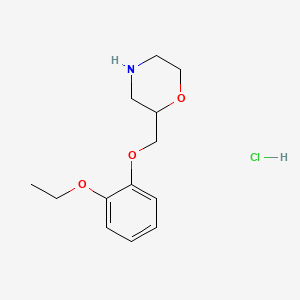Viloxazine Hydrochloride
- Viloxazine hydrochloride
- 35604-67-2
- 2-((2-Ethoxyphenoxy)methyl)morpholine hydrochloride
- Viloxazine HCl
- Vicilan
- Create:2005-08-08
- Modify:2025-01-25
 Viloxazine (has active moiety).
Viloxazine (has active moiety).
- Emovit
- ICI-58,834
- ICI58,834
- Viloxazine
- Viloxazine Hydrochloride
- Viloxazine Hydrochloride, (R)-Isomer
- Viloxazine Hydrochloride, (S)-Isomer
- Viloxazine Oxalate (1:1)
- Viloxazine, (+-)-Isomer
- Viloxazine, (R)-Isomer
- Viloxazine, (S)-Isomer
- Vivalan
- Viloxazine hydrochloride
- 35604-67-2
- 2-((2-Ethoxyphenoxy)methyl)morpholine hydrochloride
- Viloxazine HCl
- Vicilan
- Vivalan
- Emovit
- 2-[(2-ethoxyphenoxy)methyl]morpholine hydrochloride
- rac Viloxazine Hydrochloride
- Viloxacina clorhidrato
- ICI 58,834
- CCRIS 1915
- Qelbree
- Viloxazine hydrochloride [USAN]
- 2-[(2-ethoxyphenoxy)methyl]morpholine;hydrochloride
- EINECS 252-638-6
- UNII-OQW30I1332
- 2-((2-ethoxyphenoxy)methyl)morpholinehydrochloride
- DTXSID8057722
- SPN-812
- OQW30I1332
- ICI-58834
- Viloxazine (hydrochloride)
- 2-((o-Ethoxyphenoxy)methyl)morpholine hydrochloride
- C13H20ClNO3
- Morpholine, 2-((2-ethoxyphenoxy)methyl)-, hydrochloride
- DTXCID9031511
- 2-(2-Ethoxyphenoxymethyl)tetrahydro-1,4-oxazine hydrochloride
- 2-(2-Ethoxyphenoxymethyl)-2,3,5,6-tetrahydro-1,4-oxazine hydrochloride
- Morpholine, 2-[(2-ethoxyphenoxy)methyl]-, hydrochloride
- Viloxazine hydrochloride (USAN)
- (+/-)-MORPHOLINE, 2-((2-ETHOXYPHENOXY)METHYL)-, HYDROCHLORIDE
- VILOXAZINE HYDROCHLORIDE (MART.)
- VILOXAZINE HYDROCHLORIDE [MART.]
- Viloxacina clorhidrato [Spanish]
- 2-[(O-Ethoxyphenoxy)methyl]morpholine hydrochloride
- Prestwick_734
- Qelbree (TN)
- Vivalan (TN)
- 2-[(2-ethoxy phenoxy)methyl]morpholine hydrochloride
- Cloridrato de Viloxazina
- Chlorhydrate de viloxazine
- SCHEMBL300741
- CHEMBL2106483
- GLXC-25714
- Tox21_113955
- VILOXAZINE HYDROCHLORIDE [MI]
- AKOS015847050
- AT27980
- CCG-220828
- NCGC00262964-01
- VILOXAZINE HYDROCHLORIDE [WHO-DD]
- DA-49286
- CAS-35604-67-2
- DB-260468
- HY-125784
- A6217
- CS-0099324
- NS00089256
- VILOXAZINE HYDROCHLORIDE [ORANGE BOOK]
- D02572
- EN300-255420
- 2-(o-ethoxyphenoxymethyl)morpholine hydrochloride
- SR-01000872636
- SR-01000872636-1
- W-110863
- 2-(2-Ethoxy-phenoxymethyl)-morpholine; hydrochloride
- 2-[(2-Ethoxy phenoxy)methyl ]morpholine hydrochloride
- 2-[(2-Ethoxyphenoxy)-methyl]morpholine hydrochloride
- Q27285797
- 2-(2-ethoxy-phenoxymethyl)-tetra-hydro-1,4-oxazine hydrochloride
 Viloxazine (has active moiety)
Viloxazine (has active moiety)
P264, P270, P301+P317, P330, and P501
(The corresponding statement to each P-code can be found at the GHS Classification page.)
Aggregated GHS information provided per 39 reports by companies from 1 notifications to the ECHA C&L Inventory.
Information may vary between notifications depending on impurities, additives, and other factors. The percentage value in parenthesis indicates the notified classification ratio from companies that provide hazard codes. Only hazard codes with percentage values above 10% are shown.
◉ Summary of Use during Lactation
There is no published experience with viloxazine during breastfeeding. If viloxazine is required by the mother of an older infant, it is not a reason to discontinue breastfeeding, but until more data become available, an alternate drug may be preferred, especially while nursing a newborn or preterm infant.
◉ Effects in Breastfed Infants
Relevant published information was not found as of the revision date.
◉ Effects on Lactation and Breastmilk
Relevant published information was not found as of the revision date.
Patents are available for this chemical structure:
https://patentscope.wipo.int/search/en/result.jsf?inchikey=HJOCKFVCMLCPTP-UHFFFAOYSA-N
- CAS Common ChemistryLICENSEThe data from CAS Common Chemistry is provided under a CC-BY-NC 4.0 license, unless otherwise stated.https://creativecommons.org/licenses/by-nc/4.0/Viloxazine hydrochloridehttps://commonchemistry.cas.org/detail?cas_rn=35604-67-2
- ChemIDplusViloxazine hydrochloride [USAN]https://pubchem.ncbi.nlm.nih.gov/substance/?source=chemidplus&sourceid=0035604672ChemIDplus Chemical Information Classificationhttps://pubchem.ncbi.nlm.nih.gov/source/ChemIDplus
- EPA DSSToxViloxazine hydrochloridehttps://comptox.epa.gov/dashboard/DTXSID8057722CompTox Chemicals Dashboard Chemical Listshttps://comptox.epa.gov/dashboard/chemical-lists/
- European Chemicals Agency (ECHA)LICENSEUse of the information, documents and data from the ECHA website is subject to the terms and conditions of this Legal Notice, and subject to other binding limitations provided for under applicable law, the information, documents and data made available on the ECHA website may be reproduced, distributed and/or used, totally or in part, for non-commercial purposes provided that ECHA is acknowledged as the source: "Source: European Chemicals Agency, http://echa.europa.eu/". Such acknowledgement must be included in each copy of the material. ECHA permits and encourages organisations and individuals to create links to the ECHA website under the following cumulative conditions: Links can only be made to webpages that provide a link to the Legal Notice page.https://echa.europa.eu/web/guest/legal-notice2-[(2-ethoxyphenoxy)methyl]morpholine hydrochloridehttps://echa.europa.eu/substance-information/-/substanceinfo/100.047.8382-[(2-ethoxyphenoxy)methyl]morpholine hydrochloride (EC: 252-638-6)https://echa.europa.eu/information-on-chemicals/cl-inventory-database/-/discli/details/95998
- FDA Global Substance Registration System (GSRS)LICENSEUnless otherwise noted, the contents of the FDA website (www.fda.gov), both text and graphics, are not copyrighted. They are in the public domain and may be republished, reprinted and otherwise used freely by anyone without the need to obtain permission from FDA. Credit to the U.S. Food and Drug Administration as the source is appreciated but not required.https://www.fda.gov/about-fda/about-website/website-policies#linkingVILOXAZINE HYDROCHLORIDEhttps://gsrs.ncats.nih.gov/ginas/app/beta/substances/OQW30I1332
- New Zealand Environmental Protection Authority (EPA)LICENSEThis work is licensed under the Creative Commons Attribution-ShareAlike 4.0 International licence.https://www.epa.govt.nz/about-this-site/general-copyright-statement/Morpholine, 2-(2-ethoxyphenoxy)methyl-, hydrochloridehttps://www.epa.govt.nz/industry-areas/hazardous-substances/guidance-for-importers-and-manufacturers/hazardous-substances-databases/
- ChEMBLLICENSEAccess to the web interface of ChEMBL is made under the EBI's Terms of Use (http://www.ebi.ac.uk/Information/termsofuse.html). The ChEMBL data is made available on a Creative Commons Attribution-Share Alike 3.0 Unported License (http://creativecommons.org/licenses/by-sa/3.0/).http://www.ebi.ac.uk/Information/termsofuse.html
- Drug Gene Interaction database (DGIdb)LICENSEThe data used in DGIdb is all open access and where possible made available as raw data dumps in the downloads section.http://www.dgidb.org/downloadsVILOXAZINE HYDROCHLORIDEhttps://www.dgidb.org/drugs/chembl:CHEMBL2106483VILOXAZINE HYDROCHLORIDEhttps://www.dgidb.org/drugs/rxcui:142143
- Therapeutic Target Database (TTD)
- ClinicalTrials.govLICENSEThe ClinicalTrials.gov data carry an international copyright outside the United States and its Territories or Possessions. Some ClinicalTrials.gov data may be subject to the copyright of third parties; you should consult these entities for any additional terms of use.https://clinicaltrials.gov/ct2/about-site/terms-conditions#Use
- DailyMedVILOXAZINE HYDROCHLORIDEhttps://dailymed.nlm.nih.gov/dailymed/search.cfm?labeltype=all&query=VILOXAZINE+HYDROCHLORIDE
- Drugs and Lactation Database (LactMed)
- Drugs@FDALICENSEUnless otherwise noted, the contents of the FDA website (www.fda.gov), both text and graphics, are not copyrighted. They are in the public domain and may be republished, reprinted and otherwise used freely by anyone without the need to obtain permission from FDA. Credit to the U.S. Food and Drug Administration as the source is appreciated but not required.https://www.fda.gov/about-fda/about-website/website-policies#linking
- FDA Medication GuidesLICENSEUnless otherwise noted, the contents of the FDA website (www.fda.gov), both text and graphics, are not copyrighted. They are in the public domain and may be republished, reprinted and otherwise used freely by anyone without the need to obtain permission from FDA. Credit to the U.S. Food and Drug Administration as the source is appreciated but not required.https://www.fda.gov/about-fda/about-website/website-policies#linkingQELBREEhttps://dps.fda.gov/medguide
- FDA Orange BookLICENSEUnless otherwise noted, the contents of the FDA website (www.fda.gov), both text and graphics, are not copyrighted. They are in the public domain and may be republished, reprinted and otherwise used freely by anyone without the need to obtain permission from FDA. Credit to the U.S. Food and Drug Administration as the source is appreciated but not required.https://www.fda.gov/about-fda/about-website/website-policies#linking
- KEGGLICENSEAcademic users may freely use the KEGG website. Non-academic use of KEGG generally requires a commercial licensehttps://www.kegg.jp/kegg/legal.htmlUSP drug classificationhttp://www.genome.jp/kegg-bin/get_htext?br08302.kegAnatomical Therapeutic Chemical (ATC) classificationhttp://www.genome.jp/kegg-bin/get_htext?br08303.kegTarget-based classification of drugshttp://www.genome.jp/kegg-bin/get_htext?br08310.keg
- National Drug Code (NDC) DirectoryLICENSEUnless otherwise noted, the contents of the FDA website (www.fda.gov), both text and graphics, are not copyrighted. They are in the public domain and may be republished, reprinted and otherwise used freely by anyone without the need to obtain permission from FDA. Credit to the U.S. Food and Drug Administration as the source is appreciated but not required.https://www.fda.gov/about-fda/about-website/website-policies#linkingVILOXAZINE HYDROCHLORIDEhttps://www.fda.gov/drugs/drug-approvals-and-databases/national-drug-code-directory
- NCI Thesaurus (NCIt)LICENSEUnless otherwise indicated, all text within NCI products is free of copyright and may be reused without our permission. Credit the National Cancer Institute as the source.https://www.cancer.gov/policies/copyright-reuseNCI Thesaurushttps://ncit.nci.nih.gov
- NLM RxNorm TerminologyLICENSEThe RxNorm Terminology is created by the National Library of Medicine (NLM) and is in the public domain and may be republished, reprinted and otherwise used freely by anyone without the need to obtain permission from NLM. Credit to the U.S. National Library of Medicine as the source is appreciated but not required. The full RxNorm dataset requires a free license.https://www.nlm.nih.gov/research/umls/rxnorm/docs/termsofservice.htmlviloxazine hydrochloridehttps://rxnav.nlm.nih.gov/id/rxnorm/142143
- Open TargetsLICENSEDatasets generated by the Open Targets Platform are freely available for download.https://platform-docs.opentargets.org/licenceVILOXAZINE HYDROCHLORIDEhttps://platform.opentargets.org/drug/CHEMBL2106483
- SpectraBaseViloxazine HClhttps://spectrabase.com/spectrum/EXrT2YVYQG7
- Springer Nature
- Wikidataviloxazine hydrochloridehttps://www.wikidata.org/wiki/Q27285797
- Medical Subject Headings (MeSH)LICENSEWorks produced by the U.S. government are not subject to copyright protection in the United States. Any such works found on National Library of Medicine (NLM) Web sites may be freely used or reproduced without permission in the U.S.https://www.nlm.nih.gov/copyright.htmlAdrenergic Uptake Inhibitorshttps://www.ncbi.nlm.nih.gov/mesh/68018759Antidepressive Agents, Second-Generationhttps://www.ncbi.nlm.nih.gov/mesh/68018687
- PubChem
- GHS Classification (UNECE)GHS Classification Treehttp://www.unece.org/trans/danger/publi/ghs/ghs_welcome_e.html
- NORMAN Suspect List ExchangeLICENSEData: CC-BY 4.0; Code (hosted by ECI, LCSB): Artistic-2.0https://creativecommons.org/licenses/by/4.0/NORMAN Suspect List Exchange Classificationhttps://www.norman-network.com/nds/SLE/
- MolGenieMolGenie Organic Chemistry Ontologyhttps://github.com/MolGenie/ontology/
- PATENTSCOPE (WIPO)SID 389153143https://pubchem.ncbi.nlm.nih.gov/substance/389153143


 CID 313 (Hydrochloric Acid)
CID 313 (Hydrochloric Acid)